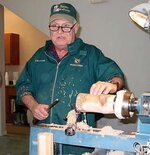DrD
Member
Good afternoon all. Following a year off due to a whole host of medical issues mostly all related to growing old, I'm slowly getting back into the shop.
I used to do a lot of turning with African Blackwood, and never noticed any issues with "open grain." However, using some newer - approx 6-10 years old - stock, I see there is quite a bit of open grain. As part of the finishing process a did a thin coat or 2 of Myland's sanding sealer followed by several medium to thick coats of walnut oil, light sanding and buffing between successive coats. The finished product has quite a bit of noticable open grain, not unlike what one might see with an oil finished Paduk.
I hate to ask such an obvious question, but ... would this issue "disappear" with more/heavier coats of sanding sealer? Any and all help is appreciated.
I didn't include any photos as all attempts on my part failed to show the open grain structure.
Thanks, Don
I used to do a lot of turning with African Blackwood, and never noticed any issues with "open grain." However, using some newer - approx 6-10 years old - stock, I see there is quite a bit of open grain. As part of the finishing process a did a thin coat or 2 of Myland's sanding sealer followed by several medium to thick coats of walnut oil, light sanding and buffing between successive coats. The finished product has quite a bit of noticable open grain, not unlike what one might see with an oil finished Paduk.
I hate to ask such an obvious question, but ... would this issue "disappear" with more/heavier coats of sanding sealer? Any and all help is appreciated.
I didn't include any photos as all attempts on my part failed to show the open grain structure.
Thanks, Don

